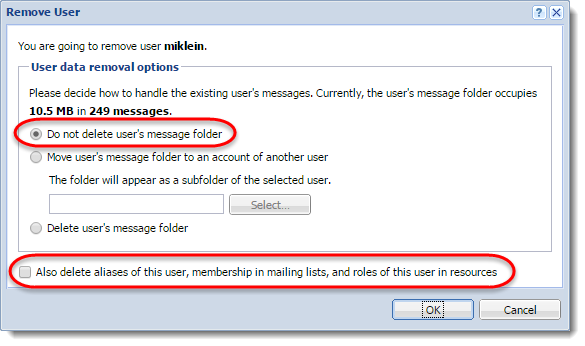Migrating from current installations to Kerio Connect Multi-Server
NOTE
This information designed for Kerio Connect Multi-Server 9
If you are using Kerio Connect, you can easily migrate your current installation to Kerio Connect Multi-Server.
NOTE
Before you start the migration, back up your data. For more information refer to Configuring backup in Kerio Connect.
 Migrating from Kerio Connect connected to a directory service
Migrating from Kerio Connect connected to a directory service
If you are using a directory service for user management, you must install Kerio Connect Multi-Server, connect it to a directory service, and migrate users from the original server.
Connecting Kerio Connect Multi-Server to a directory service
- Install the Kerio Connect Multi-Server puppet master server.
- Install the Kerio Connect Multi-Server directory server.
- Install one Kerio Connect Multi-Server back-end server. This is the master server.
- Log in to the back-end server administration and go to the Configuration > Domains section.
- Double-click your domain and go to the Directory Service tab.
- Configure the connection to your directory server. For more information refer to Connecting Kerio Connect to directory service.
- Continue installing the remaining servers: additional back-ends, instant messaging, front-end, and Zabbix. For more information refer to Installing Kerio Connect Multi-Server. The directory server configuration is automatically distributed to all servers.
If you use KerberosAn authentication protocol for client/server applications. authentication, you must configure it on each back-end server separately. For more information refer to Joining Kerio Connect running on Linux to Open Directory or Active Directory.
Migrating users and data from your Kerio Connect
To migrate your users and their data to the new Kerio Connect Multi-Server installation:
- On the original Kerio Connect server, go to Configuration > Domains.
- Click the Distributed Domains button.
- Click Next.
- Type the hostname of the first back-end server (master server) of your Kerio Connect Multi-Server, and the username and password of its admin.
- Click Connect. The original server is now connected to your Kerio Connect Multi-Server.
- On a back-end server, go to Accounts > Users and migrate all users from the original to the back-end server. For more information refer to Migrating users between the back-end servers.
- Disconnect the original server from the distributed domain in Kerio Connect Multi-Server.
Now you can start using Kerio Connect Multi-Server.
 Migrating from a Kerio Connect distributed domain
Migrating from a Kerio Connect distributed domain
If you are using a Kerio Connect distributed domain, you must install Kerio Connect Multi-Server, connect it to a directory service, and migrate users from the original servers.
To install Kerio Connect Multi-Server and connect it to a directory service, read Connecting Kerio Connect Multi-Server to a directory service, above.
Migrating users and data from your distributed domain
To migrate your users and their data to the new Kerio Connect Multi-Server installation, do the following for each server in your distributed domain:
- Disconnect the server from the distributed domain. For more information refer to Disconnecting server from distributed domain.
- On that server, go to Configuration > Domains.
- Click the Distributed Domains button.
- Click Next.
- Type the hostname of the first back-end server (master server) of your Kerio Connect Multi-Server, and the username and password of its admin.
- Click Connect. The server is now connected to your Kerio Connect Multi-Server.
- On a back-end server, go to Accounts > Users and migrate all users from the original to the back-end server. For more information refer to Migrating users between the back-end servers.
- Disconnect the server from the distributed domain in Kerio Connect Multi-Server.
Now you can start using Kerio Connect Multi-Server.
 Migrating from Kerio Connect with a local user database
Migrating from Kerio Connect with a local user database
If you have Kerio Connect with a local database of users, you must install Kerio Connect Multi-Server, connect it to a directory service, create users in the directory service and migrate the users from the original server.
Follow the instructions in Connecting Kerio Connect Multi-Server to a directory service (above), then perform the migration using the steps below.
Migrating users and data from your server with a local database
To migrate your users and their data to the new Kerio Connect Multi-Server, you must remove the users from the original server, connect this server to Kerio Connect Multi-Server directory server, create the same users on the original server, and then migrate them to a back-end server.
- On the original Kerio Connect server, go to Accounts > Users.
- Remove all local users.
While removing users, in the Remove User dialog box, select Do not delete user's message folder and uncheck the Also delete aliases of this user... option.

- Connect the server to the Kerio Connect Multi-Server directory server by editing the configuration file. For more information refer to Mapping users/groups from an OpenLDAP or Generic LDAP server.
- On the original server, create users with the same usernames as before. For more information refer to Creating users in Kerio Connect Multi-Server.
- On that server, go to Configuration > Domains.
- Click Distributed Domains.
- Click Next.
- Type the hostname of the first back-end server (master server) of your Kerio Connect Multi-Server, and the username and password of its admin.
- Click Connect. The original server is now connected to your Kerio Connect Multi-Server.
- On a back-end server, go to Accounts > Users and migrate all users from the original to the back-end server. For more information refer to Migrating users between the back-end servers.
- Disconnect the original server from the distributed domain in Kerio Connect Multi-Server.
Now you can start using Kerio Connect Multi-Server.